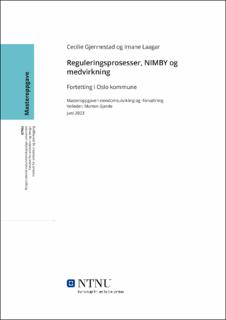| dc.contributor.advisor | Morten Gjerde | |
| dc.contributor.author | Cecilie Gjennestad | |
| dc.contributor.author | Imane Laagar | |
| dc.date.accessioned | 2023-10-11T17:21:07Z | |
| dc.date.available | 2023-10-11T17:21:07Z | |
| dc.date.issued | 2023 | |
| dc.identifier | no.ntnu:inspera:147161071:66437931 | |
| dc.identifier.uri | https://hdl.handle.net/11250/3095878 | |
| dc.description.abstract | Denne oppgaven har tatt for seg motstand mot utbyggingsprosjekter fra berørte naboer og deres opplevelse av å bli hørt og ha innflytelse i reguleringsprosesser i Oslo kommune. Det teoretiske rammeverket har tatt utgangspunkt i en nøytral tilnærming for å undersøke problemstillingen: «Naboene protesterer. Blir de hørt eller ikke?»
Studien involverte åtte dybdeintervjuer med ulike aktører, inkludert tre utbyggere, to naboer, en ansatt i Plan- og bygningsetaten (PBE), en arkitekt og en politiker. Fire utbyggingsprosjekter i Oslo kommune ble analysert som case-studie, hvorav to tilfeller der naboene fikk gjennomslag for sine merknader og to tilfeller der naboene ikke fikk gjennomslag for sine merknader.
Det sentrale i studien var naboers forventninger om å bli hørt og ha innflytelse i reguleringsprosesser i sitt nabolag. Konklusjonen på problemstillingen var at naboer faktisk blir hørt i reguleringsprosesser i samsvar med prosedyrene som er etablert av Oslo kommune og i tråd med gjeldende regelverk. Imidlertid ble det identifisert en forventning blant naboene om ikke bare å bli hørt, men også å ha reell innflytelse i utbyggingsprosjekter som påvirker deres nabolag. Det ble avdekket at de ulike aktørene i reguleringsprosessen har ulike intensjoner og forståelse av medvirkning.
Studien understreket at reguleringsprosessene i seg selv gir rom for naboers innspill, men at det er begrenset grad av innflytelse de kan ha i praksis. Dette kan skyldes strukturelle begrensninger og juridiske rammer som styrer prosessene. Det kan også skyldes at reguleringsprosessen er vanskelig å forstå og kulturelle og språklige utfordringer i ulike nabolag. Resultatene indikerer at det er et gap mellom naboers forventninger og den reelle muligheten til å påvirke utbyggingsprosjekter i sine nabolag.
I lys av disse funnene foreslår studien en forenkling av medvirkningsprosess og videre forskning på kulturelle og språklige kommunikasjonsutfordringer i reguleringsprosesser. Det er også nødvendig med økt bevissthet og forståelse hos naboer om rammene for reguleringsprosessene. Dette kan bidra til å redusere misnøye og skape større aksept for utbyggingsprosjekter i nabolagene, samtidig som naboers interesser blir ivaretatt på en mer tilfredsstillende måte. | |
| dc.description.abstract | This assignment has focused on resistance to development projects from affected neighbors and their experience of being heard and having influence in the regulatory processes in the municipality of Oslo. The theoretical framework has taken a neutral approach to investigate the research question: "Neighbors protest. Are they being heard or not?"
The study involved eight in-depth interviews with various actors, including three developers, two neighbors, an employee of the Planning and Building Agency (PBE), an architect, and a politician. Four development projects in the municipality of Oslo were analyzed as case studies, two of which involved neighbors' comments being considered and two cases where neighbors' comments were not taken into account.
The key focus of the study was the neighbors' expectations of being heard and having influence in the regulatory processes in their neighborhoods. The conclusion to the research question was that neighbors do indeed get heard in regulatory processes in accordance with the procedures established by the Oslo municipality and in line with current regulations. However, an expectation was identified among the neighbors not only to be heard but also to have real influence in development projects that affect their neighborhoods. It was uncovered that the various actors in the regulatory process have different intentions and understandings of participation.
The study emphasized that the regulatory processes themselves provide opportunities for neighbors' input, but there is a limited degree of influence they can have in practice. This may be due to structural limitations and legal frameworks that govern the processes. It may also be attributed to the difficulty in understanding the regulatory process and cultural and linguistic challenges in different neighborhoods. The results indicate a gap between neighbors' expectations and the actual ability to influence development projects in their neighborhoods.
In light of these findings, the study proposes simplifying the participation process and further research on cultural and linguistic communication challenges in regulatory processes. Increased awareness and understanding among neighbors about the frameworks of the regulatory processes are also necessary. This can help reduce dissatisfaction and create greater acceptance for development projects in neighborhoods while ensuring that neighbors' interests are better addressed. | |
| dc.language | nob | |
| dc.publisher | NTNU | |
| dc.title | Reguleringsprosesser, NIMBY og medvirkning
Fortetting i Oslo kommune | |
| dc.type | Master thesis | |
